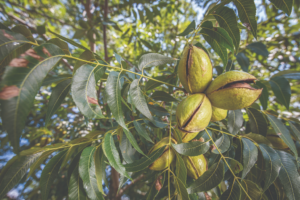Pecan Tree Selection
go.ncsu.edu/readext?645071
en Español / em Português
El inglés es el idioma de control de esta página. En la medida en que haya algún conflicto entre la traducción al inglés y la traducción, el inglés prevalece.
Al hacer clic en el enlace de traducción se activa un servicio de traducción gratuito para convertir la página al español. Al igual que con cualquier traducción por Internet, la conversión no es sensible al contexto y puede que no traduzca el texto en su significado original. NC State Extension no garantiza la exactitud del texto traducido. Por favor, tenga en cuenta que algunas aplicaciones y/o servicios pueden no funcionar como se espera cuando se traducen.
Português
Inglês é o idioma de controle desta página. Na medida que haja algum conflito entre o texto original em Inglês e a tradução, o Inglês prevalece.
Ao clicar no link de tradução, um serviço gratuito de tradução será ativado para converter a página para o Português. Como em qualquer tradução pela internet, a conversão não é sensivel ao contexto e pode não ocorrer a tradução para o significado orginal. O serviço de Extensão da Carolina do Norte (NC State Extension) não garante a exatidão do texto traduzido. Por favor, observe que algumas funções ou serviços podem não funcionar como esperado após a tradução.
English
English is the controlling language of this page. To the extent there is any conflict between the English text and the translation, English controls.
Clicking on the translation link activates a free translation service to convert the page to Spanish. As with any Internet translation, the conversion is not context-sensitive and may not translate the text to its original meaning. NC State Extension does not guarantee the accuracy of the translated text. Please note that some applications and/or services may not function as expected when translated.
Collapse ▲
UGA CAES Extension CCBY2
Pecan trees (Carya illinoinensis) are relatively affordable and bring beauty, shade, and food to your landscape. Cultivar selection is the most important factor in purchasing pecan trees. Select varieties that are resistant to pecan scab. In North Carolina, pecan scab is the most damaging disease to pecans. It is difficult to control because many homeowners are unable to adequately apply pesticides on a large tree.
Pollination is the second most important factor in purchasing pecan trees. Pecan trees are monoecious: they have separate male and female flowers on the same tree. Pollen is not released when flowers are receptive, so pollination within and between the same cultivars is limited. Cultivars are separated into type I and type II for pollination purposes. For optimum pollination, NC State Extension recommends planting at least three cultivars with at least one of each pollination type. Type I cultivars include ‘Cape Fear’ and ‘Pawnee.’ Type II cultivars include ‘Stuart’, ‘Sumner’, ‘Forkert’, ‘Gloria Grande’, ‘Kiowa’, ‘Chickasaw’, and ‘Elliot.’
All cultivars have positive and negative attributes, so do your research before purchasing. Purchased pecan trees are grafted scions onto rootstock. Nuts that are collected and planted, or seedling trees, will not produce the same nuts as the parent tree. Each nut or seedling tree is a unique species and will have traits from the mother and father tree. This tends to result in variable nut quality.
Pecan trees should be planted in late January and early February. Dig the planting hole deep and wide enough for the root system without curling the roots. Plant the tree so that the bud or graft union is at least 2 inches above the soil surface after planting and soil settling. For more information, see Growing Pecans in North Carolina.
—Brad Hardison


